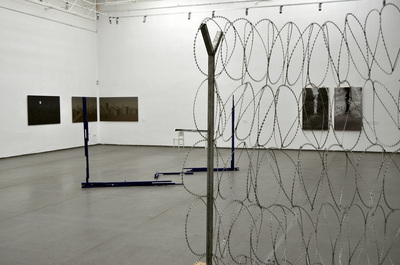τόπος - topographies - ...topias
(group exhibition)
13 - 31 May 2016
Rayko Alexiev Gallery, Sofia, Bulgaria
Participants: Alexander Valchev, Georgi Ruzhev, Dan Tenev, Dessislava Morosova, Ivo Bistrichki,
Kamen Startchev, Peter Tzanev, Rossen Toshev, Slav Nedev, Stela Vassileva, Stefan Petrunov,
Philip Popoff
Curated by Slav Nedev
The exhibition catalog could be downloaded from the Archive section or here.
Kamen Startchev, Peter Tzanev, Rossen Toshev, Slav Nedev, Stela Vassileva, Stefan Petrunov,
Philip Popoff
Curated by Slav Nedev
The exhibition catalog could be downloaded from the Archive section or here.
“Things need to have space first [of all]”
Aristotle[1]
The Ancient Greeks had two[2] words for place that partially overlap but still have different meanings. These are chóra (Greek χώρα, region/world) and tópos (Greek τόποσς, region/place). With a certain simplification we could say that if chóra is a place in general, tópos is a differentiated place that "contains other things and is defined by those things"[3], i.e. a place that is rationalized through its content.
A quick historical review will show that the place has always been and remains of primary importance to man and every living creature. An importance that often leads to arguments and even wars. Countless expeditions have been made in the past to discover and conquer new territories. Expeditions are made even today but in space. For every enterprise, for every specific activity places are necessary that have specific qualities and that should be developed or prepared in specific ways. Sciences have emerged (geography, topography etc.) that explore the place in its various aspects. There is a multitude of activities (architecture, construction etc.) whose purposes are the transformation and the utilization of the place. Various social and political projects have been made, fictitious or (semi-)realized with varying success, for which enormous efforts and lots of people have been sacrificed. Even today we witness large immigrant flows to supposedly better places for life.
... Because to have place means to exist.
The exhibition offers various views on the Place (τόπος) as an open, differentiated, explored and developed space; developed not only as a fait accompli but as a process and project as well.
Slav Nedev
[1] Aristotle, Physics, Book ІV, Part І. The quoted words are a commentary to Hesiod’s Theogony.
In addition, Isaak Lenhart (referring to Algra, K. (1994). Concepts of space in Greek Thought.) writes in his paper Kairotopos: A reflection on Greek space/time concepts as design implications in Minecraft (2011), “It is important to note that the Greeks did not make a large linguistic difference between ‘space’ and ’place’ as we currently understand those terms.”
[1] In fact they had a third concept too – „kenon“, (Ancient Greek κενόν) that could mean: (a) pure emptiness, for example “nothingness”, (b) emptiness-as-a-void-space, for example between molecules, and (c) emptiness-as-an-empty-container, for example an empty bottle. (Algra 1994). The common thing between the meanings of kenon is there-where-something-is-not. (Lenhart, Is. 2011)
[1] Lenhart, Is. (2011). Kairotopos: A reflection on Greek space/time concepts as design implications in Minecraft, DiGRA '11 - Proceedings of the 2011 DiGRA International Conference: Think Design Play. „Tópos is a location where things come together, it is a location which is a container for other things and is defined by those things. It is materially the same as chóra, but made less abstract by the property of relativeness, i.e. that it is set apart by what it contains.“
Header image: Detail of an old map of the Flenskampen Mountain, Norway.
In addition, Isaak Lenhart (referring to Algra, K. (1994). Concepts of space in Greek Thought.) writes in his paper Kairotopos: A reflection on Greek space/time concepts as design implications in Minecraft (2011), “It is important to note that the Greeks did not make a large linguistic difference between ‘space’ and ’place’ as we currently understand those terms.”
[1] In fact they had a third concept too – „kenon“, (Ancient Greek κενόν) that could mean: (a) pure emptiness, for example “nothingness”, (b) emptiness-as-a-void-space, for example between molecules, and (c) emptiness-as-an-empty-container, for example an empty bottle. (Algra 1994). The common thing between the meanings of kenon is there-where-something-is-not. (Lenhart, Is. 2011)
[1] Lenhart, Is. (2011). Kairotopos: A reflection on Greek space/time concepts as design implications in Minecraft, DiGRA '11 - Proceedings of the 2011 DiGRA International Conference: Think Design Play. „Tópos is a location where things come together, it is a location which is a container for other things and is defined by those things. It is materially the same as chóra, but made less abstract by the property of relativeness, i.e. that it is set apart by what it contains.“
Header image: Detail of an old map of the Flenskampen Mountain, Norway.
A short video by Stefan Petrunov showing the exhibition and its opening.
© 2017 Stefan Petrunov
© 2017 Stefan Petrunov
|
The exhibition τόπος - topographies - ...topias is looking for the philosophy of the places.
A conversation with Slav Nedev for Horizon until Midday - a broadcast of the BNR. Moderated by: Irina Nedeva 2016.05.17 (Bulgarian) Изложбата Топос – топографии – ...топии търси философията на местата. Разговор със Слав Недев за предаването Хоризонт до обед на БНР. Водещ: Ирина Недева (На български) © 2016 Bulgarian National Radio |
A short video report about the group exhibition τόπος - topographies - ...topias made for the morning show Denyat Zapochva s Kultura (Eng. The Day Starts with Culture) of the Bulgarian National Television.
Taken: 19 May 2016 / Broadcasted: 26 May 2016
© 2016 Bulgarian National Television
Taken: 19 May 2016 / Broadcasted: 26 May 2016
© 2016 Bulgarian National Television
All Images and texts unless otherwise stated are copyrighted. © Copyright by Slav Nedev. All Rights Reserved.
















